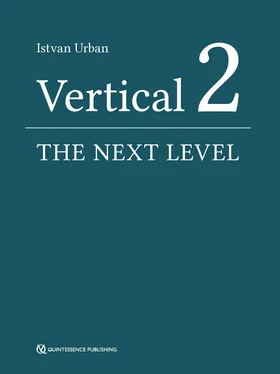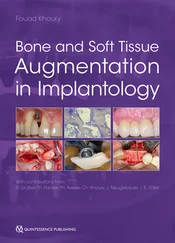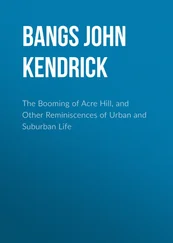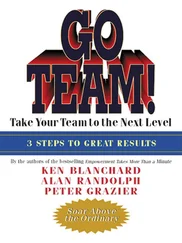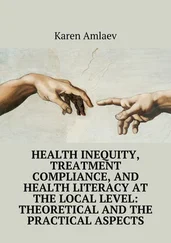Istvan Urban
Vertical 2
Istvan Urban
THE NEXT LEVEL
OF HARD AND SOFT TISSUE AUGMENTATION

 |
One book, one tree: In support of reforestation worldwide and to address the climate crisis, for every book sold Quintessence Publishing will plant a tree ( https://onetreeplanted.org/). |
A CIP record for this book is available from the British Library.
ISBN: 978-3-86867-592-4

| Quintessenz Verlags-GmbH |
Quintessence Publishing Co Ltd |
| Ifenpfad 2–4 |
Grafton Road, New Malden |
| 12107 Berlin |
Surrey KT3 3AB |
| Germany |
United Kingdom |
| www.quintessence-publishing.com |
www.quintessence-publishing.com |
Copyright © 2022
Quintessenz Verlags-GmbH
All rights reserved. This book or any part thereof may not be reproduced, stored in a retrieval system, or transmitted in any form or by any means, electronic, mechanical, photocopying, or otherwise, without prior written permission of the publisher.
Editing: Avril du Plessis, Quintessenz Verlags-GmbH, Berlin, Germany
Layout and Production: Janina Kuhn, Quintessenz Verlags-GmbH, Berlin, Germany
Reproduction: Quintessenz Verlags-GmbH, Berlin, Germany
It has been almost 5 years since the publication of my first book, Vertical and Horizontal Ridge Augmentation: New Perspectives by Quintessence Publishing in 2017. That book has enjoyed great success and has been translated into 12 languages, helping the guided bone regeneration (GBR) technique to be practiced successfully worldwide.
The reader might expect this book to be a second edition. It is not. I had a lot more to share, and this book delves more into the details where the devil lives. I anticipate that you will read this book armed with the knowledge from the first book as regards the anatomy, principles of mandibular surgery, anterior maxillary defect types and their treatment options, and soft tissue reconstruction after bone grafting. It is important that you please review this information from the first book before reading this new one.
Parts of this book are like watching a surgical video with me, where I stop the video at the most important parts (sometimes frame by frame) and discuss with you, the reader, what I am thinking and doing at that step, and what my next step will be. At the same time, I discuss the reason for each of these steps.
In addition, the greatly appreciated ‘Lessons learned’ sections are again included in this book. I consider these sections to be very important, since one can always identify a part of the procedure that one could have done better. These sections also help to emphasize the most important learning objectives of the case.
Please note that one could describe this book as a kind of atlas, a ‘show-and-tell,’ so to speak, where in many places the images, drawings, radiographs, charts, and tables tell the story. For this reason, some chapters contain a minimum of text, and the figures are not always ‘called out’ in the text in a way you may be accustomed to. The idea was to keep things as clear and simple as possible; the figure legends always explain exactly what is going on.
The section on the mandible is more detailed in this book than it was in my first book; also, it focuses on larger defects as well as different surgical steps in native, fibrotic, and scarred tissue types around the mental nerve during flap advancement. The section on the posterior maxilla will hopefully help to solve many issues such as the management of complications of sinus grafting and the lack of buccal, crestal or nasal bony walls of the posterior maxilla before bone grafting.
This book sheds light on the detail in treating the anterior maxilla that has not been published previously. You are finally getting the ‘complete package,’ including treatment options such as the fast track, the safe track or the technical track of soft tissue reconstruction in conjunction with bone grafting. Questions are answered such as: What options do I have when there are multiple implants in regenerated bone and I would like to reconstruct the papilla? The Ice-cube and Iceberg connective tissue graft techniques are the best options, but how do I actually do them, and how do I choose between the two techniques?
I have great expectations for this book, and I really wish that I had had this knowledge two decades ago. I could have had the most perfect cases today. That is what I am expecting for you, dear reader – to make the most perfect cases based on the principles described in this book.
At the same time, as I have said elsewhere, I like to keep procedures simple, repeatable, and biologically sound. The techniques presented here are not overcomplicated – they are simple treatment strategies with lower complication rates and more predictability in the final outcome. Therefore, I would like to welcome you and thank you for reading this book, and remind you of a quote by Leonardo da Vinci: “Simplicity is the ultimate sophistication.”
Some of the cases in this book were not finalized by the time of publication. For additional material and to see the final clinical outcomes of these cases, please scan the QR code on the right or go to the following link:
https://www.quint.link/vertical2mat

I would like to thank my family for their love and endless support, and our two sons, Isti and Marci, for their existence, spirit, and positive outlook on life. You make our life complete. As a child (and ever since), my parents never interfered in any of the decisions I made, as they believed in the development of the individual with only minimal guidance. I believe they were right, and I thank them for that.
My teachers, who were my teachers during my training, continue to be my teachers and will remain my teachers. Special thanks to Dr. Henry Takei for his inspiration and unsurpassed qualities as a humanitarian, both as an educator and as a periodontist. Special thanks also to Dr. Jaime Lozada for his belief in me as a student at Loma Linda University and his confidence that I would go on to do vertical ridge augmentation. I would also like to thank Dr. Sascha Jovanovic for introducing me to performing GBR in a biologically sound way. Thanks also to Dr. Joseph Kan, Dr.Perry Klokkevold, Dr. Anna Pogany, Dr. Bela Kovacs, and Dr. Lajos Patonay, and to all my other teachers. Without meeting all of you and being your student, there would be much less to say in this book.
I would like to express my appreciation to Quintessence Publishing, specifically to the management, Horst Wolfgang Haase and Christian Haase.
I would like to express my gratitude to Ms. Krisztina Szample for creating the schematic drawings, and to Denes Doboveczki for assisting in the photography for this book.
I would also like to thank Ms. Jacqueline Kalbach of The Avenues Company for her support in the preparation of my manuscripts, and of this book.
Читать дальше
